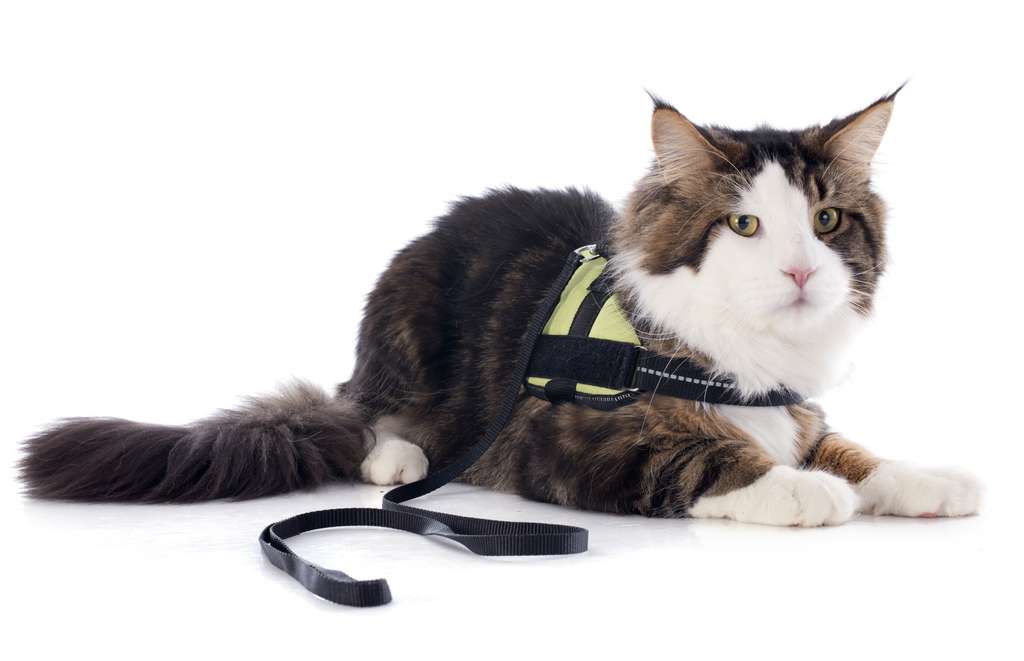Introduction
When it comes to training animals, cats are often seen as independent and untrainable creatures. However, with the right techniques and patience, it is indeed possible to harness train a cat. Harness training allows cats to safely explore the outdoors while still being under your control. It can be a great way to provide mental and physical stimulation for your feline friend, as well as strengthen the bond between you and your pet.
Before diving into the process of harness training, it is important to understand the benefits it can offer. Cats are naturally curious creatures, and being able to explore the outside world can provide them with a much-needed outlet for their energy. Harness training can also be a safer alternative to letting your cat roam freely outdoors, as it reduces the risk of them getting lost or injured. Additionally, harness training can help build trust and confidence in your cat, as they learn to navigate new environments with your guidance.
One of the first steps in harness training a cat is to choose the right harness and leash. It is crucial to select a harness that fits properly and is comfortable for your cat to wear. Look for a harness specifically designed for cats, as they have a different body structure compared to dogs. Avoid using collars, as they can be harmful to cats and may cause injury. Once you have the appropriate harness, introduce it to your cat gradually. Allow them to sniff and investigate the harness before attempting to put it on.
Once your cat is comfortable with the harness, you can begin the training process. Start by putting the harness on your cat for short periods of time indoors, allowing them to get used to the sensation of wearing it. Reward your cat with treats and praise during these training sessions to reinforce positive associations with the harness. Gradually increase the duration of wearing the harness, and once your cat is comfortable, you can start attaching the leash and practicing walking indoors. Remember to be patient and take it at your cat’s pace, as some cats may take longer to adjust to the harness and leash.

How long does it take for a cat to get used to a harness?
Getting a cat used to wearing a harness can be a challenging process that requires patience and consistency. Every cat is different, so the time it takes for a cat to get used to a harness can vary. Some cats may adapt quickly, while others may take longer to feel comfortable wearing a harness.
When introducing a harness to a cat, it is important to start slowly and gradually increase the amount of time the cat spends wearing it. Begin by allowing the cat to sniff and investigate the harness while it is lying on the ground. This will help the cat become familiar with the scent and appearance of the harness.
Once the cat is comfortable with the harness being in its environment, gently place the harness on the cat’s back for short periods of time. It is important to monitor the cat’s behavior during this process. If the cat becomes stressed or anxious, it may be necessary to remove the harness and try again later.
Over time, gradually increase the length of time the cat wears the harness. This can be done by attaching a leash to the harness and allowing the cat to walk around the house while supervised. It is important to provide positive reinforcement, such as treats or praise, during this process to help the cat associate wearing the harness with positive experiences.
It is important to remember that every cat is unique and may require different amounts of time to become comfortable wearing a harness. Some cats may take only a few days to adjust, while others may take several weeks or even months. Patience and consistency are key when training a cat to wear a harness.
Is it too late to train my cat?
Training a cat can be a challenging task, especially if they are older. Many people believe that cats cannot be trained once they reach a certain age, but this is not necessarily true. While it may be more difficult to train an older cat compared to a kitten, it is definitely not too late to start training.
Firstly, it is important to understand that cats are highly intelligent animals and can learn new behaviors at any age. They may not be as eager to please their owners as dogs, but with patience and consistency, they can be trained to follow basic commands and even perform tricks.
Secondly, it is important to start training as soon as possible. The earlier you start training your cat, the easier it will be to establish good behaviors and prevent bad habits from forming. However, even if you have an older cat, it is never too late to begin training. Cats are creatures of habit, and with time and repetition, they can learn new behaviors.
Thirdly, it is important to use positive reinforcement techniques when training your cat. Cats respond well to rewards and praise, so be sure to reward them with treats or affection when they exhibit the desired behavior. Avoid using punishment or negative reinforcement, as this can cause fear and anxiety in your cat, making training even more difficult.
Lastly, it is important to be patient and consistent when training your cat. Cats may take longer to learn new behaviors compared to dogs, so it is important to be patient and not give up. Consistency is also key, as cats thrive on routine and repetition. Set aside regular training sessions and stick to them, even if progress seems slow at first.
At what age do cats stop misbehaving?
There is no specific age at which cats stop misbehaving, as their behavior can vary greatly depending on their individual personality, breed, and environment. However, it is generally believed that cats tend to become less mischievous as they mature and reach adulthood.
During their kittenhood, cats are known for their playful and curious nature. They may engage in behaviors such as scratching furniture, climbing curtains, or knocking objects off shelves. This is a normal part of their development as they explore their surroundings and learn about their environment.
As cats grow older, they typically become more settled and less inclined to engage in destructive behaviors. This is partly due to their natural instinct to establish territories and mark their scent, which can lead to behaviors such as spraying or scratching. However, these behaviors can be managed through proper training and providing appropriate outlets for their natural instincts.
It is important to note that some cats may continue to exhibit misbehavior even into adulthood. This can be due to various factors such as boredom, stress, or underlying health issues. In such cases, it is important to consult with a veterinarian or a professional animal behaviorist to address the underlying cause of the misbehavior and develop a suitable plan for correction.
Why is my cat not walking in harness?
There can be several reasons why your cat is not walking in a harness. Cats are known for their independent nature, and they may not be comfortable with the idea of being restrained or controlled. Additionally, cats have a strong instinct to explore and roam freely, and wearing a harness may restrict their movement and hinder their natural behavior.
One possible reason why your cat is not walking in a harness is that they may not have been properly introduced to it. Cats are creatures of habit and can be resistant to change. If you have recently introduced the harness to your cat, they may need some time to get used to it. It is important to introduce the harness gradually and in a positive manner, using treats and rewards to associate it with something pleasant.
Another reason could be that the harness does not fit your cat properly. Cats come in different shapes and sizes, and it is important to choose a harness that is the right size and adjustable to fit your cat comfortably. If the harness is too tight or too loose, it can cause discomfort or restrict your cat’s movement, making them reluctant to walk in it.
It is also possible that your cat simply does not enjoy the sensation of wearing a harness. Some cats are more sensitive than others and may find the feeling of having something strapped to their body unpleasant. In such cases, it may be worth considering alternative options, such as a leash or a catio, to provide your cat with outdoor stimulation while ensuring their safety.
Can cat sleep with harness on?
Yes, cats can sleep with a harness on. Many cat owners use harnesses to take their cats for walks or to allow them to explore the outdoors safely. While it may seem uncomfortable for a cat to sleep with a harness on, they can actually become quite accustomed to it and find it comforting.
When introducing a harness to a cat, it is important to do so gradually and with patience. Start by allowing the cat to wear the harness for short periods of time while they are awake and supervised. This will help them get used to the feeling of wearing it and prevent any potential discomfort or anxiety.
Once the cat is comfortable wearing the harness during waking hours, it is safe for them to sleep with it on. In fact, some cats may even prefer to sleep with their harness on as it provides a sense of security and familiarity. However, it is important to regularly check the harness for any signs of wear or damage to ensure the cat’s safety.
It is worth noting that not all cats will be comfortable wearing a harness, and some may never adjust to it. If a cat shows signs of distress or discomfort while wearing a harness, it is best to remove it and find alternative ways to provide them with exercise and stimulation.
What are the steps involved in harness training a cat?
Harness training a cat involves several steps to ensure a successful and safe experience for both the cat and the owner. The first step is to introduce the cat to the harness gradually. Start by placing the harness near the cat’s sleeping area or favorite spot, allowing them to sniff and investigate it at their own pace. Once the cat is comfortable with the presence of the harness, gently place it on their back for short periods of time, gradually increasing the duration as they become more accustomed to wearing it.
The next step is to attach the leash to the harness and allow the cat to walk around indoors. This helps them get used to the sensation of being restrained and guided by the leash. It’s important to supervise the cat closely during this stage to prevent any accidents or entanglements. Once the cat is comfortable walking indoors, gradually introduce them to the outdoors in a controlled and safe environment, such as a fenced yard or a quiet park. Always keep a close eye on the cat’s behavior and body language to ensure they are comfortable and not experiencing any distress.
Overall, harness training a cat requires patience, consistency, and positive reinforcement. It’s important to remember that not all cats may take to harness training, and it’s essential to respect their individual preferences and comfort levels. By following these steps and providing a positive and safe training experience, you can increase the chances of successfully harness training your cat.
Are there any specific techniques or tools that can be used to harness train a cat?
When it comes to harness training a cat, there are several techniques and tools that can be used to make the process easier and more successful. One popular technique is known as desensitization, which involves gradually introducing the cat to the harness and allowing them to become comfortable with it over time. This can be done by initially placing the harness near the cat and rewarding them with treats or praise for positive behavior. As the cat becomes more comfortable, the harness can be placed on their body for short periods of time, gradually increasing the duration as they become more accustomed to wearing it.
Another technique that can be effective is positive reinforcement. This involves rewarding the cat with treats, praise, or playtime whenever they exhibit desired behaviors during the harness training process. By associating the harness with positive experiences, the cat is more likely to view it as a positive and enjoyable part of their routine.
In terms of tools, there are various types of harnesses available specifically designed for cats. These harnesses typically have adjustable straps and secure closures to ensure a proper fit and prevent the cat from escaping. It’s important to choose a harness that is comfortable for the cat and allows for freedom of movement while still providing control and safety.
How long does it typically take to successfully harness train a cat?
Harness training a cat can be a time-consuming process that requires patience and consistency. The length of time it takes to successfully harness train a cat can vary depending on several factors, including the individual cat’s personality, previous experiences, and the training techniques used.
On average, it can take anywhere from a few weeks to several months to fully harness train a cat. Some cats may quickly adapt to wearing a harness and walking on a leash, while others may take longer to feel comfortable and confident in their new gear.
It is important to remember that every cat is unique and will progress at their own pace. Some cats may require more time and repetition to become accustomed to the harness, while others may take to it more quickly. Consistency and positive reinforcement are key during the training process.
Are there any potential challenges or difficulties that may arise during the harness training process?
Yes, there can be several challenges and difficulties that may arise during the harness training process for cats. One common challenge is resistance from the cat. Cats are known for their independent nature, and they may initially resist wearing a harness or walking on a leash. They may try to wriggle out of the harness or refuse to move while wearing it. This can require patience and persistence from the owner to gradually acclimate the cat to the harness and leash.
Another challenge is the cat’s reaction to the outdoors. Cats are naturally curious, but they can also be easily startled or frightened by unfamiliar sights, sounds, and smells. This can make it difficult to keep the cat calm and focused during the training sessions. It may take time for the cat to become comfortable with the outdoor environment and learn to walk confidently on a leash.
What are the benefits of harness training a cat, and how can it enhance their overall well-being?
Harness training a cat can have numerous benefits for both the cat and their owner. One of the main advantages is that it allows cats to safely explore the outdoors while still being under control. Cats are naturally curious creatures, and being able to experience the sights, sounds, and smells of the outside world can greatly enrich their lives. By harness training them, owners can provide a safe and controlled environment for their cats to enjoy the outdoors, reducing the risk of accidents or getting lost.
Additionally, harness training can provide mental and physical stimulation for cats. It allows them to engage in activities such as walking, climbing, and exploring, which can help prevent boredom and promote a healthier lifestyle. Regular exercise is important for cats to maintain a healthy weight and prevent obesity-related health issues. Harness training can also help build a stronger bond between cats and their owners, as it provides an opportunity for shared experiences and quality time together.
In terms of enhancing their overall well-being, harness training can also help reduce stress and anxiety in cats. Many cats are prone to anxiety, especially when faced with new environments or situations. By gradually introducing them to the harness and the outdoors, owners can help their cats become more confident and comfortable in different settings. This can have a positive impact on their overall mental health and well-being.

Conclusion
Harness training a cat can be a challenging but rewarding process. By following the steps outlined in this guide, cat owners can successfully train their feline companions to wear a harness and enjoy outdoor adventures together. It is important to remember that each cat is unique and may require different approaches and levels of patience. However, with consistency, positive reinforcement, and a gradual introduction to the harness, cats can learn to associate it with positive experiences and eventually become comfortable wearing it.
One of the key factors in successfully harness training a cat is to start the process early. Kittens are generally more adaptable and open to new experiences, making it easier to introduce them to a harness. However, adult cats can also be trained with patience and persistence. It is important to start by familiarizing the cat with the harness in a positive and non-threatening way, such as leaving it near their sleeping area or incorporating it into playtime. Gradually, the cat can be introduced to wearing the harness for short periods of time indoors, allowing them to adjust to the sensation and weight.
Another important aspect of harness training is to use positive reinforcement techniques. Cats respond well to rewards and praise, so it is important to reward them with treats or affection whenever they show progress or display calm behavior while wearing the harness. It is also crucial to avoid punishment or forceful methods, as this can create negative associations with the harness and hinder the training process.



No Comments